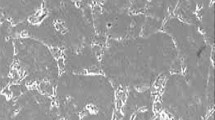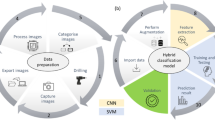Abstract
Multi-material stacks comprising composite and metallic layers are widely used in aerospace components. For the assembly of structural part, high-quality holes are required to ensure the performance of the mechanical fastening (rivet/bolt). On the final assembly lines of aircraft structures, these machining operations are often performed using an electric automated drilling unit (eADU). When drilling hybrid stacks, the difference in machinability of the materials (CFRP, titanium alloy, and aluminum alloy) makes it difficult to avoid delamination, fibre pullout, matrix degradation, burrs, roughness, and size defects. Therefore, each material must be drilled with suitable machining conditions to meet the demanding quality requirements. To this end, automated material detection would allow for the adjustment of appropriate cutting parameters for each material. Due to the numerous stack configurations (material, thickness) and the variability of process parameters (tool geometry, cutting conditions, lubrication, etc.), automated material detection is not an easy task. To address this issue in eADU applications, this paper presents a novel approach to identify during the process the drilled material being manufactured using a random forest (RF) machine learning model and multi-sensor data fusion. Cutting forces, vibration, micro-lubrication conditions (flow rate and pressure), and eADU spindle and feed motor currents are monitored on a dedicated drilling test rig. Numerous tests were performed on Al7175/CFRP stacks with different cutting conditions to validate the proposed methodology. Advanced signal processing and analysis in the time and frequency domains are used for feature extraction to identify Al7175 from the CFRP. The input features of the RF model were selected using the feature importance measure embedded in the RF model learning process. The knowledge process of drilling multiple material stacks is also considered. The results showed that the features extracted from the frequency domain are more effective in identifying the CFRP Al7175 than those extracted from the time domain. This optimal subset was then used to build the RF model. The proposed methodology resulted in a highly accurate classification allowing the implementation of an adaptive machining process on the eADU for hybrid stack drilling.
















Similar content being viewed by others

References
Xu J, Mkaddem A, El Mansori M (2016) Recent advances in drilling hybrid FRP/Ti composite: a state-of-the-art review. Compos Struct 135:316–318. https://doi.org/10.1016/j.compstruct.2015.09.028
König W, Graß P (1989) Quality definition and assessment in drilling of fibre reinforced thermosets. CIRP Annals 38(1):119–124. https://doi.org/10.1016/S0007-8506(07)62665-1
Shyha IS, Aspinwall DK, Soo SL, Bradley S (2009) Drill geometry and operating effects when cutting small diameter holes in CFRP. Int J Mach Tools Manuf 49(12–13):1008–1014. https://doi.org/10.1016/j.ijmachtools.2009.05.009
Shyha IS, Aspinwall DK, Soo SL, Bradley S, Perry R, Harden P, Dawson S (2011) Hole quality assessment following drilling of metallic-composite stacks. Int J Mach Tools Manuf 1(7–8):569–578. https://doi.org/10.1016/j.ijmachtools.2011.04.007
Zitoune R, Krishnaraj V, Collombet F (2010) Study of drilling of composite material and aluminium stack. Compos Struct 92(5):1246–1255. https://doi.org/10.1016/j.compstruct.2009.10.010
Ramulu M, Branson T, Kim D (2001) A study on the drilling of composite and titanium stacks. Compos Struct 54(1):67–77. https://doi.org/10.1016/S0263-8223(01)00071
Sharif JS, Rahim EA (2007) Performance of coated- and uncoated-carbide tools when drilling titanium alloy—Ti–6Al4V. J. Mater. Process Technol 185(1–3):72–76. https://doi.org/10.1016/j.jmatprotec.2006.03.142
Dornfeld DA, Kim JS, Dechow H, Hewson J, Chen LJ (1999) Drilling burr formation in titanium alloy, Ti-6Al-4V. CIRP Annals 48(1):73–76. https://doi.org/10.1016/S0007-8506(07)63134-5
Jallageas J, Ayfre M, Cherif M, K’nevez JY, Cahuc O (2016) Self-adjusting cutting parameter technique for drilling multi-stacked material. SAE Int. J. Mater. Manf. 9(1):24–30. https://doi.org/10.4271/2015-01-2502
Pardo A, Heinemann R, Nobre NM, Bagshaw L (2021) Assessment of decision-making algorithms for adaptive drilling of aerospace stacks. Procedia CIRP 99:392–397. https://doi.org/10.1016/j.procir.2021.03.055
Palanikumar K, Mata FJ, Paulo Davim J (2008) Analysis of surface roughness parameters in turning of FRP tubes by PCD tool. J Mater Process Technol 204:469–474. https://doi.org/10.1016/j.jmatprotec.2007.12.088
Bonnet C, Poulachon G, Rech J, Girard Y, Costes P (2015) CFRP drilling: fundamental study of local feed force and consequences on hole exit damage. Int J Mach Tools Manuf 94:57–64. https://doi.org/10.1016/j.ijmachtools.2015.04.006
Van der Sypt P, Chérif M, Bois C (2017) CFRP drilling: Fundamental study of local feed force and consequences on hole exit damage. Int J of Fatigue 103:86–98. https://doi.org/10.1016/j.ijfatigue.2017.05.025
Zadafiya K, Bandhu D, Kumari S, Chatterjee S, Abhishek K (2021) Recent trends in drilling of carbon fiber reinforced polymers (CFRPs): a state-of-the-art review. J Manuf Processes 69:47–68. https://doi.org/10.1016/j.jmapro.2021.07.029
Xu J, Yin Y, Davim JP, Li L, Ji M, Geier N, Chen M (2022) A critical review addressing the drilling-induced damage issues for CFRP composites. Compos Struct 294:115594. https://doi.org/10.1016/j.compstruct.2022.115594
Xiao W, Huang J, Wang B, Ji H (2022) A systematic review of artificial intelligence in the detection of cutting tool breakage in machining operations. Measurement 190:110748. https://doi.org/10.1016/j.measurement.2022.110748
Sun H, Zhang J, Mo R, Zhang X (2020) In-process tool condition forecasting based on a deep learning method. Robot Comput Integr Manuf 64:101924. https://doi.org/10.1016/j.rcim.2019.101924
Caggiano A, Napolitano F, Nele L, Teti R (2018) Multiple sensor monitoring for tool wear forecast in drilling of CFRP/CFRP stacks with traditional and innovative drill bits. Procedia CIRP 67:404–409. https://doi.org/10.1016/j.procir.2017.12.233
Teti R, Segreto T, Caggiano A, Nele L (2020) Smart multi-sensor monitoring in drilling of CFRP/CFRP composite material stacks for aerospace assembly applications. Appl Sci 10(3):758. https://doi.org/10.3390/app10030758
Soualhi M, Nguyen KTP, Medjaher K (2020) Pattern recognition method of fault diagnostics based on a new health indicator for smart manufacturing. Mech Syst Signal Process 142:106680. https://doi.org/10.1016/j.ymssp.2020.106680
Ferreiro S, Sierra B, Irigoien I, Gorritxategi E (2011) Data mining for quality control: burr detection in the drilling process. Comp Ind Eng 60(4):801–810. https://doi.org/10.1016/j.cie.2011.01.018
Karnik SR, Gaitonde VN, Rubio JC, Correia AE, Abrão AM, Davim JP (2008) Delamination analysis in high speed drilling of carbon fiber reinforced plastics (CFRP) using artificial neural network model. Mater Design 29(9):1768–1776. https://doi.org/10.1016/j.matdes.2008.03.014
Hrechuk A (2023) Recognition of drilling-induced defects in fiber reinforced polymers using machine learning. Procedia CIRP 117:384–389. https://doi.org/10.1016/j.procir.2023.03.065
Domínguez-Monferrer C, Fernández-Pérez J, De Santos R, Miguélez MH, Cantero JL (2022) Machine learning approach in non-intrusive monitoring of tool wear evolution in massive CFRP automatic drilling processes in the aircraft industry. J Manuf Syst 65:622–639. https://doi.org/10.1016/j.jmsy.2022.10.018
Teti R, Mourtzis D, D'Addona DM, Caggiano A (2022) Process monitoring of machining. CIRP Annals - Manuf Techn 71:529–552. https://doi.org/10.1016/j.cirp.2022.05.009
Wang HY, Wang JS, Wang G (2022) A survey of fuzzy clustering validity evaluation methods. Info Sci 618:270–297. https://doi.org/10.1016/j.ins.2022.11.010
Neugebauer R, Ben-Hanan U, Ihlenfeldt S, Wabner M, Stoll A (2012) Acoustic emission as a tool for identifying drill position in fiber-reinforced plastic and aluminum stacks. Int J Mach Tools Manuf 57:20–26. https://doi.org/10.1016/j.ijmachtools.2012.01.013
Abellan-Nebot JV, Romero SF (2010) A review of machining monitoring systems based on artificial intelligence process models. Int J Adv Manuf Technol 47:237–257. https://doi.org/10.1007/s00170-009-2191-8
Teti R, Jemielniak K, Donnell GO, Dornfeld D (2010) Advanced monitoring of machining operations. CIRP Ann 59(2):717–739. https://doi.org/10.1016/j.cirp.2010.05.010
Duo A, Segreto T, Caggiano A, Basagoiti R, Teti R, Arrazola PJ (2021) Drilling process monitoring: a framework for data gathering and feature extraction techniques. Procedia CIRP 99:189–195. https://doi.org/10.1016/j.procir.2021.03.123
Araujo AC, Landon Y, Lagarrigue P (2021) Smart drilling for aerospace industry: state of art in research and education. Procedia CIRP 99:387–391. https://doi.org/10.1016/j.procir.2021.03.105
Thawonmas R, Abe S (1997) A novel approach to feature selection based on analysis of class regions. IEEE Trans Syst Man Cybern B Cybern 27(2):196–207 https://ieeexplore.ieee.org/document/558798
Chandrashekar G, Sahin F (2014) A survey on feature selection methods. Comp & Electrical Eng 40(1):16–28. https://doi.org/10.1016/j.compeleceng.2013.11.024
Breiman L (2001) Random forests. Machine Learn 45:5–32. https://doi.org/10.1023/A:1010933404324
Quian Y, Pattipati K, Utsav AU, Bollas G (2022) Hybrid fata-driven and model_informed online tool wear detection in milling machines. J manuf syst 63:329–342. https://doi.org/10.1016/j.jmsy.2022.04.001
Hegde C, Daigle H, Gray KE (2019) Classification of drilling stick slip severity using machine learning. J Pet Sci Eng 179:1023–1036. https://doi.org/10.1016/j.petrol.2019.05.021
Breiman L, Friedman J, Olshen R, Stone C (1984) Classification and regression trees. Chapman and Hall (Wadsworth, Inc.), New York
Turki Y, Habak M, Velasco R, Aboura Z, Khellil K, Vantomme P (2014) Experimental investigation of drilling damage and stitching effects on the mechanical behavior of carbon/epoxy composites. Int J Mach Tools Manuf 87:61–72. https://doi.org/10.1016/j.ijmachtools.2014.06.004
Pardoa A, Majeed M, Heinemann R (2020) Process signals characterisation to enable adaptive drilling of aerospace stacks. Procedia CIRP 88:479–484. http://creativecommons.org/licenses/by-nc-nd/4.0/
Funding
This work was supported by the company SETI-TEC by providing technical support and funding (CIFRE). This work also received financial support from the National Research Agency (ANR).
Author information
Authors and Affiliations
Contributions
All authors contributed to the design of the study. Material preparation, data collection, and analysis were conducted by all authors. The first draft of the manuscript was written by Abdoulaye Affadine Haoua, and all authors commented on previous versions of the manuscript. All authors read and approved the final manuscript.
Corresponding author
Ethics declarations
Competing interests
The authors declare no competing interests.
Additional information
Publisher’s note
Springer Nature remains neutral with regard to jurisdictional claims in published maps and institutional affiliations.
Rights and permissions
Springer Nature or its licensor (e.g. a society or other partner) holds exclusive rights to this article under a publishing agreement with the author(s) or other rightsholder(s); author self-archiving of the accepted manuscript version of this article is solely governed by the terms of such publishing agreement and applicable law.
About this article
Cite this article
Haoua, A.A., Rey, PA., Cherif, M. et al. Material recognition method to enable adaptive drilling of multi-material aerospace stacks. Int J Adv Manuf Technol 131, 779–796 (2024). https://doi.org/10.1007/s00170-023-12046-0
Received:
Accepted:
Published:
Issue Date:
DOI: https://doi.org/10.1007/s00170-023-12046-0



